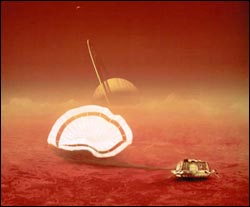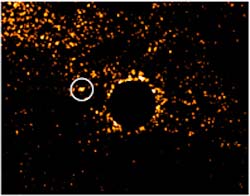This area deals with the fundamental laws and building blocks of nature and how they interact, the properties and the behavior of matter, and research into space and time and their structures.
innovations-report provides in-depth reports and articles on subjects such as astrophysics, laser technologies, nuclear, quantum, particle and solid-state physics, nanotechnologies, planetary research and findings (Mars, Venus) and developments related to the Hubble Telescope.

14 January 2005, after its seven-year journey through the Solar System on board the Cassini spacecraft, ESA’s Huygens probe has successfully descended through the atmosphere of Titan, Saturn’s largest moon, and safely landed on its surface.
The first scientific data arrived at the European Space Operations Centre (ESOC) in Darmstadt, Germany, this afternoon at 17:19 CET. Huygens is mankind’s first successful attempt to land a probe on another world in the outer Solar System. “This

Middleweight matchup to provide control data in exploration of new form of matter
Scientists searching for evidence that a particle accelerator at the U.S. Department of Energy’s Brookhaven National Laboratory has created a new form of matter not seen since the Big Bang and eager to study its properties have begun using a new experimental probe, collisions between two beams of copper ions. The use of intermediate size nuclei is expected to result in intermediate energy density

Results from experiments at CERN and the Jyväskylä Accelerator Laboratory in Finland, reported in Nature today, cast new light on the primary reaction that creates carbon in stars. All the carbon in the Universe, including that needed for carbon-based life forms such as ourselves, has been made in the hearts of stars through what is known as the “triple alpha reaction”. The new findings modify the rate at which the reaction occurs and have broad implications for astrophysics, from the formation

Turn out the light!
A collaborative team of researchers has discovered what turns the lights out from space. Using sophisticated features on a transmission electron microscope, John P. Bradley, Ph.D., Director of the Institute for Geophysics and Planetary Physics at Lawrence Livermore National Laboratory, has discovered that organic carbon and amorphous silicates in interstellar grains embedded within interplanetary dust particles (IDPs) are the carriers of the astronomical 2175 Å

Astronomers are announcing today the first results of a search for extrasolar planets and brown dwarfs in an unlikely place–the stellar graveyard. The report, titled “Searching for Extrasolar Planets in the Stellar Graveyard,” is being presented at the American Astronomical Society meeting in San Diego, California, by John Debes, a graduate student at Penn State; Steinn Sigurdsson, associate professor of astronomy and astrophysics at Penn State University; Bruce Woodgate, of the NASA Goddard Spa

An ancient mystery may have been solved by LSU Associate Professor of Physics and Astronomy Bradley E. Schaefer.
Schaefer has discovered that the long-lost star catalog of Hipparchus, which dates back to 129 B.C., appears on a Roman statue called the Farnese Atlas. Hipparchus was one of the greatest astronomers of antiquity and his star catalog was the first in the world, as well as the most influential. The catalog was lost early in the Christian era, perhaps in the fire at the gr